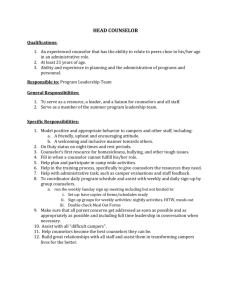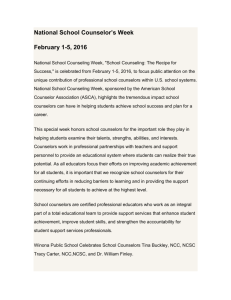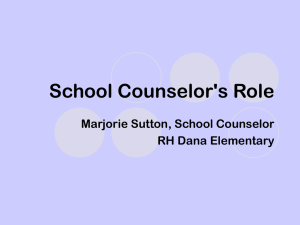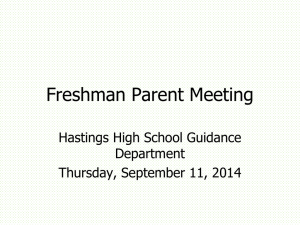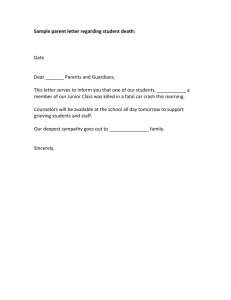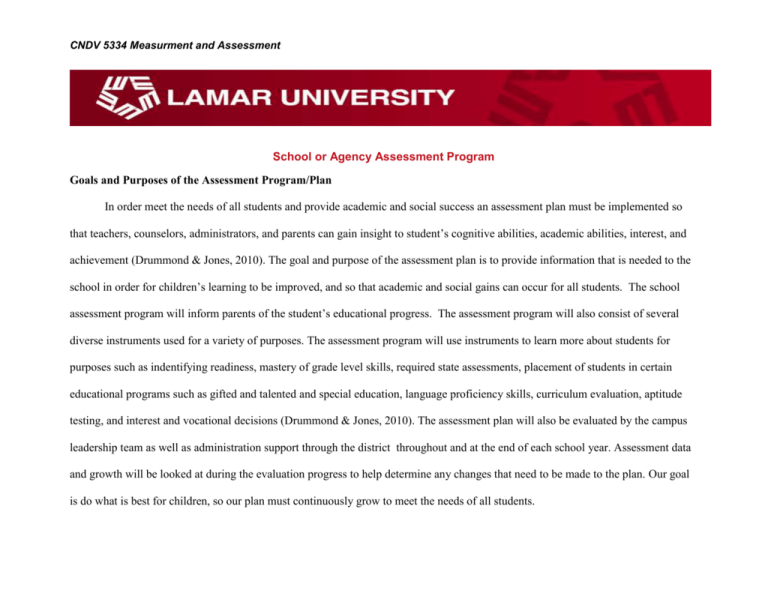
CNDV 5334 Measurment and Assessment
School or Agency Assessment Program
Goals and Purposes of the Assessment Program/Plan
In order meet the needs of all students and provide academic and social success an assessment plan must be implemented so
that teachers, counselors, administrators, and parents can gain insight to student’s cognitive abilities, academic abilities, interest, and
achievement (Drummond & Jones, 2010). The goal and purpose of the assessment plan is to provide information that is needed to the
school in order for children’s learning to be improved, and so that academic and social gains can occur for all students. The school
assessment program will inform parents of the student’s educational progress. The assessment program will also consist of several
diverse instruments used for a variety of purposes. The assessment program will use instruments to learn more about students for
purposes such as indentifying readiness, mastery of grade level skills, required state assessments, placement of students in certain
educational programs such as gifted and talented and special education, language proficiency skills, curriculum evaluation, aptitude
testing, and interest and vocational decisions (Drummond & Jones, 2010). The assessment plan will also be evaluated by the campus
leadership team as well as administration support through the district throughout and at the end of each school year. Assessment data
and growth will be looked at during the evaluation progress to help determine any changes that need to be made to the plan. Our goal
is do what is best for children, so our plan must continuously grow to meet the needs of all students.
CNDV 5334 Measurment and Assessment
Types of Information Needed to Make Decisions
Information is a pertinent piece of the assessment plan, and a responsibility that the counselor must uphold in order to have an
effective assessment plan. First, the school must have the assessment instruments for multi grade levels as well as instruments for
various reasons. Counselors will also need to synthesize data from test and on test to make certain decisions.
Counselors will need information on how to select, administer, score and interrupt the various assessments too (Drummond &
Jones, 2010). School counselors will work together with the state in order to assure that students are taking the right standardized test
on the right times. Counselors will need information regarding ethical issues with the assessments they will be administering to
students. In addition to Texas’s assessment resources, the district has an assessment calendar where further information regarding
testing dates can be found.
Certain assessments require different information needed in order for counselors to make decisions. For achievement test,
counselors will have to work with the state to coordinate and follow state guidelines for the state test. Certain rules and expectations
for special education and students with limited language will be needed. Counselors will need to know all students needs in order to
make certain decisions about testing accommodations. Counselors will need to seek the resources that TEA has to offer in regards to
state assessment. There are several assessments that are to be given throughout the year for different students.
CNDV 5334 Measurment and Assessment
In order to screen for gifted and talented or special education programs counselors will need information on students’ cognitive
ability and social ability be able to identify students who are potentially gifted or special education students (Drummond & Jones,
2010). Along with cognitive ability academic ability, creative thinking, and visual or performing arts ability is important information
when considering if a student is gifted (Drummond & Jones, 2010). Also, counselors will need to gather information from a range of
sources in order to determine the needs of students. Gathering information from students, parents, teachers and administrators gives
the counselor a perspective on the needs of the student population (Drummond & Jones, 2010). Counselors will need to look at the
state gifted education plan and follow the guidelines for selecting and assessing gifted students.
Counselors will need to be able to use a universal screening process to identify students who are at risk so that RTI services
can be delivered to those students who are in need of intervention (Drummond & Jones, 2010). It is important that students will
receive intervention to support academic or social growth, but also it is a required law. Special education laws must be followed and
TEA has valuable resources on the specifics of the law that include the state’s rule and regulations but also the federal IDEA act
("Special education rules," 2012).
Types of Instruments and Procedures for Selecting Them
In order to make sure are assessing all the needs of our students 5 different instruments will be used for assessment. Students
needs vary and if there is a need that we don’t have an instrument for, the plan can be adapted to add different instrument. There are
multiple instruments that can be used to assess student’s needs. The instruments selected relate to specific needs that students have in
CNDV 5334 Measurment and Assessment
education. They have also been determined based on their validity and reliability and relation to educational needs for all students.
Also, age group range is looked at as well when selecting instruments to use for the plan.
To assess students who are having focusing issues the Conner’s assessment will be used to measure if a student has ADHD.
This assessment can also be used to determine what interventions are needs for special education. The procedure of choosing this
instrument is that the target range population is for people ages 6-18 (Cowen, 2013). This is target range that best suits students in the
school setting. There is evidence of the assessment being reliable because of the internal consistency and the test is valid (Cowen,
2013). This assessment is well-designed instrument, beneficial in evaluation, diagnosis, and treatment (Cowen, 2013).
To measure intelligence in children the Wechsler Intelligence Scale for Children will be used to determine learning disabilities
by comparing achievement test data to Verbal IQ and Performance IQ scores (Cowen, 2013). The target population range for this
assessment is adolescents, so therefore this assessment will be used with upper elementary students and older (Cowen, 2013). This
assessment has high confidence ranges with 90-95% confidence ranges with internal consistency, and the response to program and
completed report is positive (Cowen, 2013). This assessment is valuable because it takes into consideration verbal and performance IQ
scores (Cowen, 2013). The process of selecting this test is used to determine student’s ability by looking at IQ scores. The IQ score
can help determine if a student is gifted or in need of education support (Cowen, 2013).
In addition, The Rogers, will be used to determine Advanced Placement and Gifted and Talented education by assessing
achievement. For one reason, this particular instrument is able to be used on all students. The validity and reliability has not been yet
analyzed, but the test is quick and cost efficient for school districts (Cowen, 2013).
CNDV 5334 Measurment and Assessment
The Woodcock-Munoz will be the instrument used to assess student’s language proficiency. This assessment’s target population
is for students, k-college,which is helpful to asses all students in a public school district (Cowen, 2013). In terms of reliability, the
assessment is satisfactory with high coefficients for the English test (Cowen, 2013). This instrument was primarily selected to use to
determine the language proficiency in English and Spanish at the same time (Cowen, 2013). It also measures the cognitive-academic
language proficiency (Cowen, 2013).
ATEC, Autism Treatment Evaluation Checklist, a cross culture adaptation is an instrument used to assess cross cultural
capabilities of the ATEC for children and adolescents who have been diagnosed with Autism (Cowen, 2013). The target range for this
assessment is children to adolescents, and the instrument also had high internal consistency (Cowen, 2013). Also, with a few
limitations ATEC is valid. This instrument was selected based on its reliability, validity, and population range (Cowen, 2013).
Responsibilities of the Staff
Because testing involves many stakeholders it is important for all parties involved to know their specific duties and
responsibilities to ensure that students are comfortable throughout any testing process. Many members of the school play a vital role in
making sure students are assessed adequately and properly.
One important role at the campus level is the testing coordinator. This position varies, but the role is extremely important in
making sure that appropriate test are given and given properly. First, the coordinator will make sure that all staff and personnel are
trained adequately before giving any type of assessment. The testing coordinator will work closely with the district testing director to
CNDV 5334 Measurment and Assessment
administer proper test and the proper time. The testing coordinator is responsible for receiving test materials and distributing them
properly. The coordinator will also make sure that all students are given proper test. He/she will also make sure that testing remains
confidential and will follow district and state guidelines for testing. The coordinator will make sure that confidentially is maintained
for all stakeholders.
The campus principle will assist the campus coordinator in making sure that district and state guidelines are followed. The
principle will make sure that the coordinator is meeting expectations and that teachers and staff feel supported and trained to
administer any assessments necessary. The campus principle will also help counselors designate through data so that instruction can
be affected and parents can be informed.
The campus principle will oversee all testing and help maintain a positive testing
environment for all students.
Counselors play a vital role in the assessment process. One responsibility is to consult with teachers about test and
measurement. Counselors should be able to properly and effectively explain results and data to teachers (Drummond & Jones).
Counselors need to be able to explain results so that teachers can adjust classroom instruction or environment for students (Drummond
& Jones). As well, as being able to help teachers understand results, counselors must provide coping strategies for students who suffer
from testing anxiety (Drummond & Jones). Also, counselors must be able to assess students for numerous reasons such as intellectual
ability, readiness test, aptitude, and achievement test (Drummond & Jones). Counselors will consult with the campus diagnostician,
teachers, and administrators for specific testing for specific needs for students. The counselor will continue to work along the side of
all stakeholders to ensure student academic and social success.
CNDV 5334 Measurment and Assessment
The academic liaison for each campus will dig into the testing data to help better assist students with making goals and
academic progress. The academic liaison will be responsible for meeting with certain students who are struggling to discuss progress
and to set goals. The liaison will look closely at reading and math formative, summative, district, and state assessments to help the
student determine where he or she needs to be in order to be successful. The liaison will also meet with students’ parents to discuss
what strategies and techniques can be used at home enhance academics.
For teachers, the school’s front line, they will be responsible for communicating student needs, following campus, district, and
state guidelines, and for creating a safe environment for students in. Teachers are the most valuable source when making decisions
about what a student needs. If a teacher for sees and academic or social issue, the teacher must alert the counselor and administrator so
that the process of meeting that student needs is started. Teachers must also follow mandated expectations for testing and maintain
confidentially at all times. Teachers are also required to coach students through testing anxiety and provide a comfortable place for
testing. Lastly, teachers are to use assessment results to guide instruction to better meet the needs of students.
Procedures for Disseminating Assessment Results
Because of the variety of assessments that place throughout a school year to meet the different needs of students, different
procedures will be set depending on the nature of the assessment. Some assessments results will require a more in-depth process than
others. Communicating assessment results is a highly important piece and communication should take place quickly after results are
returned to the campus (Drummond & Jones, 2010). All results should be presented in terms that parents can understand. Using
CNDV 5334 Measurment and Assessment
“educational jargon” should be reframed when possible (Drummond & Jones, 2010). Counselors should provide graphs to present
statics and other data should be communicated in summary form (Drummond & Jones, 2010). An in-depth detail of what skills or
competencies were tested uses of test results, norms used, and the results comparisons (national, state, district, grade level). Below are
specific ways that certain test results should be distributed (Drummond & Jones, 2010).
For the Conner’s assessment, the assessment will be sent off to the Administration Building, to the counseling department.
Once the counselor receives the assessment report, then a meeting will be held with all teachers who are involved with the student and
the parents. A feedback session will be held so that decisions will be made based on what the Conner’s assessment reveals.
Interventions will be agreed upon based upon results and what is best for the student.
Next, the Wechsler Intelligence Scale for Children data will be put into the student’s portfolio. When IQ’s are being looked at
this could be used for either special education testing or gifted and talented testing. The Wechsler Intelligence Scale for Children is
just a small piece of the puzzle that will help counselors, diagnostician, and administrators make decisions about student placement. A
data summary will be reviled to teachers, parents, and administrators during student placement meeting.
The Rogers test is another part of the gifted and talented testing process. This assessment test student academic achievement.
Once the results are in, the data can be added to the portfolio to help determine placement. Data and results will be reveled to teachers,
administrators, and parents at the student placement meeting quickly after the assessment results are returned to the counselor.
Furthermore, the Wood-Cock Munoz test is a cognitive language proficiency test that will be administered to all level 1 and 2
ESL students. The results of the test will be disturbed to the teacher, parents as soon as the data summary is returned to the counselor,
CNDV 5334 Measurment and Assessment
and a copy will be put in the student’s LPAC folder. The classroom teacher will meet with the counselor to review results and align
instruction to the student’s language needs.
ATEC, Autism Treatment Evaluation Checklist results will be delivered to the counselor first. The counselor will then
schedule a meeting with the classroom teacher, parent, diagnostician, and campus principle. At the meeting, the all stakeholders will
discuss student academic concerns and social concerns. Depending on the results different services will discussed and determined so
that the student will continue to be able to grow academically and socially.
Evaluation Strategy
The campus leadership team along with district personnel has a responsibility to evaluate the assessment plan and assessment
process for the school. The leadership team will evaluate whether counselors are selecting appropriate test that meet the needs of all
students in the school. Counselors will also evaluate the most commonly used assessment instruments. Also, administration and
methods of scoring assessment instruments will be evaluated. Testing environment will evaluate to see how comfortable students felt
while being assessed. Additionally, teachers provide feedback on the assessment plan, assessment procedures, and receiving results to
help drive instruction.
Teachers, students and parents will receive a survey that helps the leadership team evaluate the assessment plan. The results
will be analyzed so that amendments to the plan can be made. Also, after standardized test are given, the leadership team will meet
CNDV 5334 Measurment and Assessment
and discuss what worked and what didn’t work to ensure the smoothest testing process as possible. It will also be important for parents
and teacher to provide feedback about specific assessment process for specific student needs. When an assessment is only given to a
few students, parent and teacher feedback will be valuable. The leadership team will be consistently evaluating the assessment process
as different needs come up.
CNDV 5334 Measurment and Assessment
References
Cowen, J. (2013). Field assignment: Assessment instrument review.
Drummond, R. & Jones, K. D. (2010). Assessment procedures for counselors and helping professionals (7th Ed.). Upper Saddle
River, NJ: Pearson Prentice Hall.
Special education rules and regulations. (2012, March 27). Retrieved from http://www.tea.state.tx.us/index2.aspx?id=2147497444


